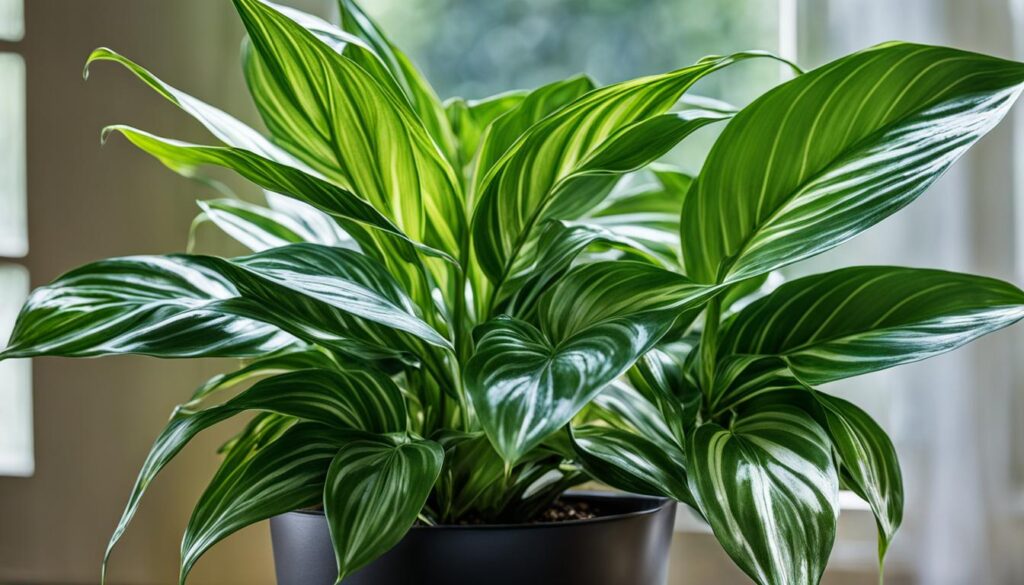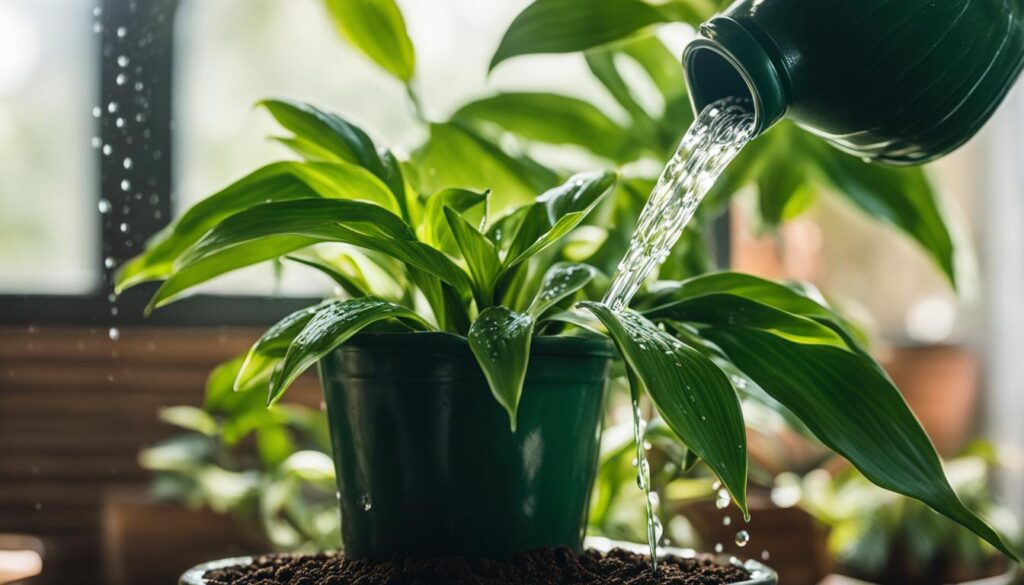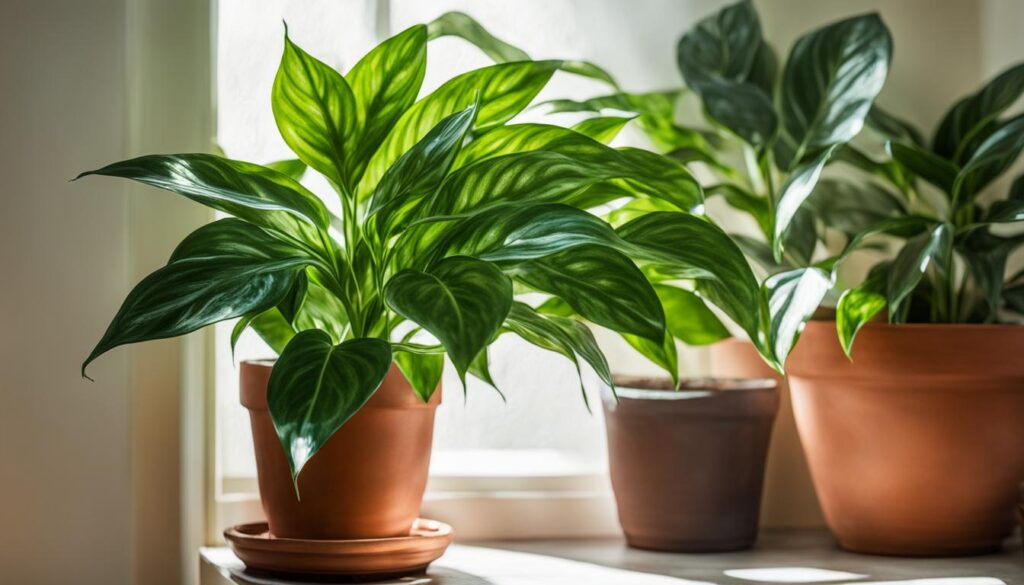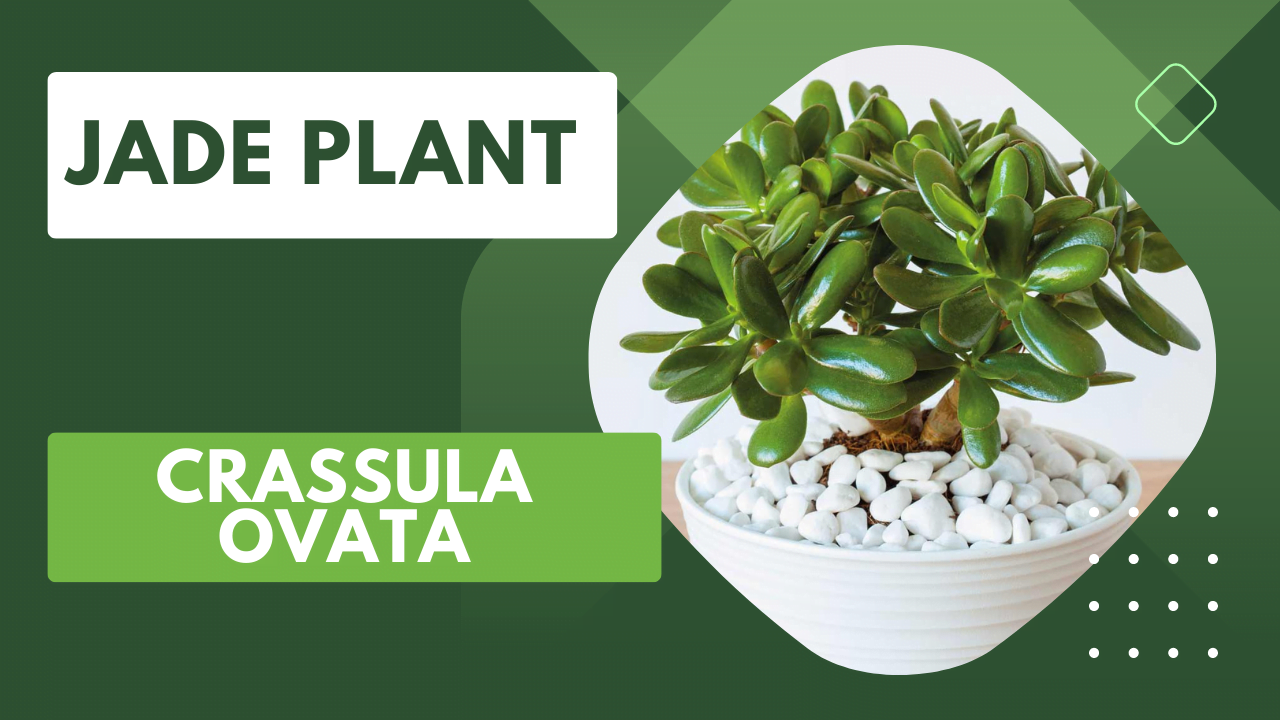Chinese Evergreen (Aglaonema) Care: Types, Watering & Soil Guide
If you’re looking to add some vibrant greenery to your indoor space, look no further than the Chinese Evergreen. This stunning Aglaonema indoor plant is perfect for both beginner and experienced plant enthusiasts. Not only does it have beautiful foliage, but it’s also relatively easy to care for.
In this guide, I’ll walk you through the essentials of how to grow Chinese Evergreen and provide you with valuable tips on how to care for Chinese Evergreen. We’ll cover everything from the different Chinese Evergreen types to watering techniques of plants and soil requirements.
But before we dive in, let’s take a moment to appreciate the mesmerizing beauty of the Chinese Evergreen. Just take a look at this stunning image:

Now, let’s get started on our journey to become successful Chinese Evergreen plant parents!
Types of Chinese Evergreen Plants
Chinese evergreen, scientifically known as Aglaonema, encompasses a wide range of beautiful cultivars that can enhance the aesthetic appeal of any indoor space. Let’s explore some of the popular types of Chinese Evergreen:
| Cultivar | Scientific Name |
|---|---|
| ‘Frasher’ | Aglaonema commutatum |
| ‘Pseudobracteatum’ | Aglaonema pictum |
| ‘White Rajah’ | Aglaonema spp. |
| ‘Red Zircon’ | Aglaonema spp. |
| ‘Silver Bay’ | Aglaonema spp. |
| ‘Maria’ | Aglaonema spp. |
These cultivars exhibit unique characteristics, patterns, and color variations, allowing you to select the perfect Chinese Evergreen that reflects your personal style and complements your home decor.
Watering Chinese Evergreen Plants
Proper watering is essential for the health and vitality of Chinese Evergreen plants. To ensure optimal growth, it is important to strike a balance between moist and well-drained soil. Overwatering can lead to root rot, while underwatering can cause the leaves to wilt and the plant to suffer.
When watering your Chinese Evergreen, it is best to thoroughly saturate the soil. Allow the excess water to drain away, ensuring that the plant is not sitting in standing water. Once the soil has slightly dried out, it is time to water again.
The frequency of watering depends on the season and environmental conditions. During the spring, summer, and fall, when the plant is actively growing, it will require more frequent watering. However, in the winter months when growth slows down, watering should be reduced.
As a general guideline, water your Chinese Evergreen once every 7 to 10 days during the growing season, and once every 2 to 3 weeks during the winter. However, it is important to monitor the moisture level of the soil and adjust the watering schedule accordingly. Always check the moisture level of the soil by sticking your finger about an inch deep into the soil. If it feels dry, it is time to water.

It’s crucial to note that the specific watering needs may vary depending on factors such as the size of the pot, the humidity levels in your environment, and the growth stage of the plant. Therefore, it is important to observe your Chinese Evergreen closely, and adjust the watering schedule as needed to maintain the ideal moisture level.
Signs of Overwatering and Underwatering
Overwatering your Chinese Evergreen can lead to yellowing leaves, wilting, and root rot. On the other hand, underwatering can cause the leaves to turn brown and crispy. By closely monitoring the condition of your plant and adjusting the watering schedule accordingly, you can prevent these issues and keep your Chinese Evergreen thriving.
| Signs of Overwatering | Signs of Underwatering |
|---|---|
| Yellowing leaves | Brown and crispy leaves |
| Wilting | Shrivelled or wrinkled leaves |
| Root rot | Stunted growth |
By understanding the watering needs of your Chinese Evergreen and closely monitoring the soil moisture, you can ensure the optimal health and growth of your plant. Remember to strike a balance between moist and well-drained soil, and adjust the watering schedule according to the season and specific conditions. With proper care, your Chinese Evergreen will thrive and bring beauty to your indoor space.
Soil Requirements for Chinese Evergreen Plants
When it comes to providing the best growing conditions for Chinese Evergreen plants, the right soil is essential. Chinese Evergreen plants prefer well-drained soil with a slightly acidic pH level. This ensures that the roots have access to the necessary nutrients and moisture without becoming waterlogged.
A peat-based potting mix is ideal for Chinese Evergreen plants as it provides excellent drainage while retaining the right amount of moisture. This type of potting mix helps prevent waterlogging, which can lead to root rot and other plant health issues.
If you are unable to find a peat-based potting mix, you can create your own by combining equal parts potting soil, peat moss, and perlite or coarse sand. This mixture will help improve drainage and provide the right balance of moisture for your Chinese Evergreen plants.
It’s important to select a pot with ample drainage holes to allow excess water to escape. This will prevent waterlogging and promote healthy root growth. Additionally, choose a pot that is slightly larger than the current one to allow room for the plant to grow.
Repotting is typically done every two to three years to provide fresh soil and give the roots more space to grow. When repotting, gently remove the plant from its current container, loosen any compacted roots, and place it into a new pot with fresh potting soil.
| Soil Requirements for Chinese Evergreen Plants | Description |
|---|---|
| Well-drained soil | Allows excess water to escape and prevents waterlogging. |
| Slightly acidic pH | Provides the right balance of nutrients for optimal growth. |
| Peat-based potting mix | Retains moisture while promoting good drainage. |
| Perlite or coarse sand | Improves drainage in the potting mix. |
| Ample drainage holes | Prevents waterlogging and promotes healthy root growth. |
Light Exposure for Chinese Evergreen Plants
When it comes to light requirements, Chinese Evergreen plants thrive in bright indirect light. They can tolerate lower light conditions, making them suitable for various areas of your home. However, direct sunlight should be avoided as it can harm the delicate leaves. The key is to strike a balance between providing sufficient light and protecting the plant from intense sun exposure.
In general, darker green varieties of Chinese Evergreen can do well in near-shade or partially shaded areas of your home. These varieties are more tolerant of lower light conditions and can still grow and thrive. On the other hand, variegated varieties with striking patterns and colors require a bit more bright light to maintain their vibrant foliage.
To ensure optimal light exposure for your Chinese Evergreen plant, place it in a draft-free area near a window that receives bright indirect light. This allows the foliage to benefit from the natural light without being directly exposed to the harmful rays of the sun. By following this placement strategy, you can create an environment that mimics its native habitat, where it receives filtered light through the forest canopy.

Remember, maintaining the right amount of light exposure is crucial for the health and vitality of your Chinese Evergreen. Too much direct sunlight can lead to leaf scorching and damage, while insufficient light may result in leggy growth and reduced vibrancy.
Now that you know how to meet the light requirements of your Chinese Evergreen, let’s explore tips for creating the ideal humidity and temperature levels in the next section.
Tips for Humidity and Temperature for Chinese Evergreen Plants
Proper humidity and temperature are essential for the health and well-being of your Chinese Evergreen plant. Maintaining the right conditions will ensure that your plant thrives and displays its beautiful foliage to the fullest extent. In this section, I will provide you with some useful tips to create an ideal environment for your Chinese Evergreen.
Humidity
Chinese Evergreen plants prefer high humidity levels, ranging between 60% to 70%. Adequate humidity is essential for maintaining healthy foliage and preventing issues such as brown, crispy leaf edges.
You can increase humidity around your Chinese Evergreen through the following methods:
- Mist the leaves regularly using a spray bottle filled with water. This will provide a localized increase in humidity around the plant.
- Place the plant in a bathroom or kitchen, areas naturally more humid due to steam from showers or cooking.
- Use a small space humidifier to maintain optimal humidity levels. This is especially useful if your home has dry indoor air.
By implementing these humidity-boosting techniques, you can create a comfortable environment for your Chinese Evergreen, mimicking its natural habitat.
Temperature
Chinese Evergreen plants thrive in temperatures between 65 to 80 degrees Fahrenheit. It is crucial to keep your plant away from cold drafts or temperatures below 70 degrees Fahrenheit, as it is sensitive to cold conditions.
Here are some temperature-related tips for your Chinese Evergreen:
- Ensure that the plant is placed in a location with a consistent temperature within its preferred range.
- Avoid exposing the plant to sudden temperature changes or cold drafts from windows or ventilation.
- During colder months, make sure to keep the plant away from heating vents or radiators, as excessive heat can negatively affect its health.
By providing your Chinese Evergreen with optimal temperature conditions, you can promote healthy growth and vibrant foliage.
A well-maintained humidity and temperature balance will ensure the success of your Chinese Evergreen plant. Remember to monitor humidity levels regularly and adjust as needed to provide the best growing environment. As you continue caring for your Chinese Evergreen, keep these tips in mind to enjoy a thriving and visually stunning houseplant.
Fertilizing and Propagation of Chinese Evergreen Plants
Proper fertilizing and propagation are essential for the health and growth of Chinese Evergreen plants. Here are some tips to help you fertilize and propagate your Chinese Evergreen successfully.
Fertilizing Chinese Evergreen
Chinese Evergreen plants benefit from regular fertilization to promote healthy foliage and vibrant growth. It is recommended to fertilize your Chinese Evergreen twice a year using slow-release pellets or liquid fertilizer. Follow the instructions on the product label for the correct dosage and application.
When selecting a fertilizer, choose one specifically formulated for houseplants or foliage plants. Look for a balanced fertilizer with a ratio of equal parts nitrogen (N), phosphorus (P), and potassium (K), such as a 10-10-10 or 20-20-20 fertilizer.
During the growing season, from spring to fall, fertilize your Chinese Evergreen every two to four weeks. However, reduce or stop fertilization during the dormant winter months as the plant’s growth slows down.
Propagation of Chinese Evergreen
Chinese Evergreen plants can be propagated through stem cuttings or division. Both methods are relatively easy and yield successful results.
Propagation through Stem Cuttings:
1. Select a healthy stem with several leaves from the parent plant.
2. Using clean, sharp scissors or a knife, cut a 4-6 inch section of the stem just below a leaf node.
3. Remove the lower leaves from the stem, leaving a few at the top.
4. Place the cutting in a glass or container of water, ensuring that the bottom end is submerged.
5. Place the glass or container in a spot with bright, indirect light.
6. Change the water every few days to prevent stagnation and fungal growth.
7. Once roots have developed, usually within a few weeks, transplant the cutting into a small pot filled with well-draining potting soil.
8. Keep the soil consistently moist but not waterlogged until the new plant establishes itself.
Propagation through Division:
1. During repotting, carefully remove the parent plant from its container.
2. Gently separate the plant into smaller sections, ensuring that each section has its own roots and foliage.
3. Replant each divided section into its own individual pot with fresh, well-draining potting soil.
4. Water the newly divided plants thoroughly and monitor their moisture levels to promote root development.
By fertilizing and propagating your Chinese Evergreen plants correctly, you can ensure their continued growth and beauty in your indoor space.
Conclusion
In conclusion, caring for a Chinese Evergreen plant is a rewarding and enjoyable experience. By following the provided care tips and guidelines, you can ensure the health and longevity of your Chinese Evergreen.
Remember to water your plant properly, allowing the soil to dry out slightly between waterings to avoid overwatering. Choose a well-drained potting mix that provides the right balance of moisture and nutrients for optimal growth.
Provide your Chinese Evergreen with the right amount of light exposure, avoiding direct sunlight to prevent leaf burn. Additionally, create a humid environment for your plant by misting it regularly or using a humidifier, as it thrives in higher humidity levels.
With its stunning foliage and various cultivars to choose from, the Chinese Evergreen is a popular addition to any indoor space. Follow these Chinese Evergreen care tips, and you’ll have a thriving and beautiful plant that brings life and vibrancy to your home.
FAQ
How often should I water my Chinese Evergreen plant?
Chinese Evergreen plants should be watered thoroughly and then allowed to dry out slightly before watering again. During the spring, summer, and fall, water more frequently, and reduce watering in the winter.
What type of soil is best for Chinese Evergreen plants?
Chinese Evergreen plants prefer well-drained soil with a slightly acidic pH. A peat-based potting mix is ideal, but you can also add sand or perlite to improve drainage.
How much light does a Chinese Evergreen plant need?
Chinese Evergreen plants prefer bright indirect light, but they can tolerate lower light conditions. Darker green varieties can grow in near-shade, while variegated varieties require a bit more bright light. However, direct sunlight should be avoided as it can burn the leaves.
What are the humidity requirements for Chinese Evergreen plants?
Chinese Evergreen plants prefer high humidity levels of around 60 to 70%. You can increase humidity by misting the plant frequently, placing it in a humidity-prone area of your home, or using a small space humidifier.
How do I fertilize and propagate a Chinese Evergreen plant?
Chinese Evergreen plants can be fertilized with slow-release pellets or liquid fertilizer twice a year, following the product label instructions. Propagation can be done through stem cuttings or division. Stem cuttings can be rooted in water and then potted in well-draining soil. Division can be done during repotting by separating the plants at the roots and replanting them in separate pots with fresh soil.
Are Chinese Evergreen plants toxic to pets?
Yes, Chinese Evergreen plants are toxic to dogs and cats. Caution should be taken if you have pets and you should keep them away from the plant or choose a pet-friendly alternative.




